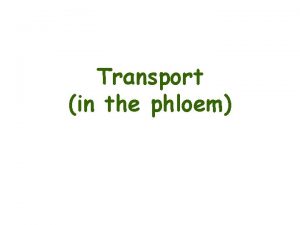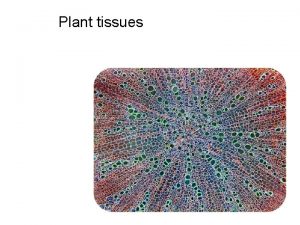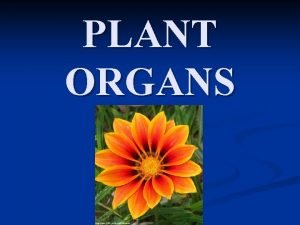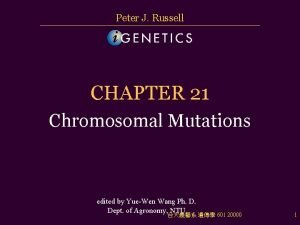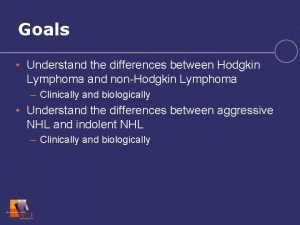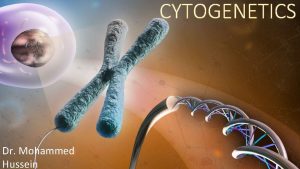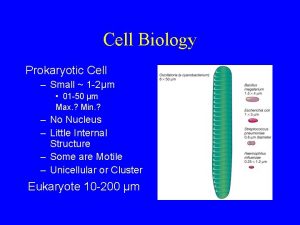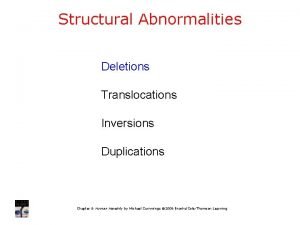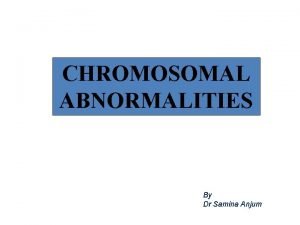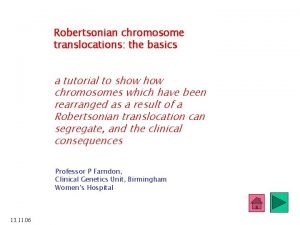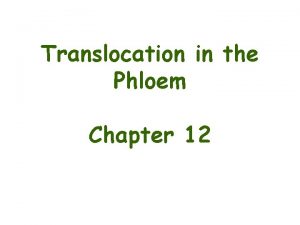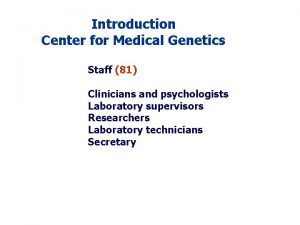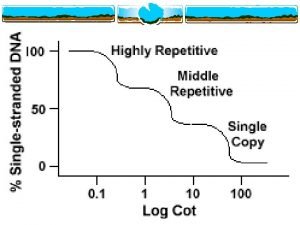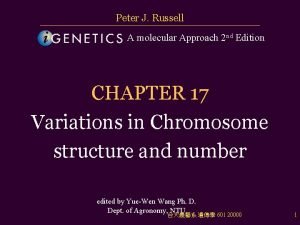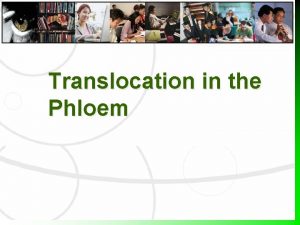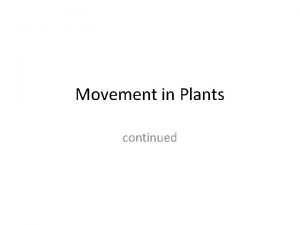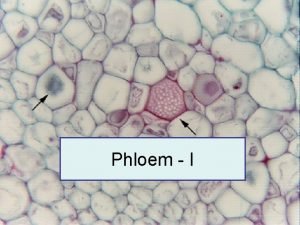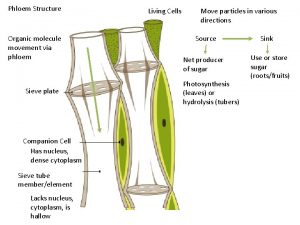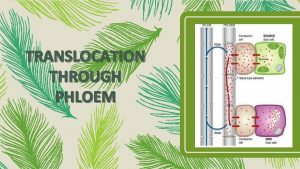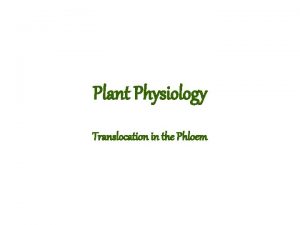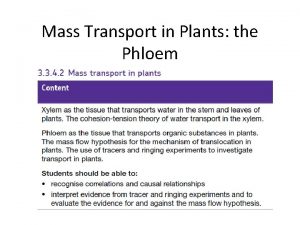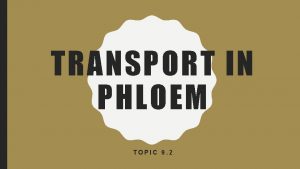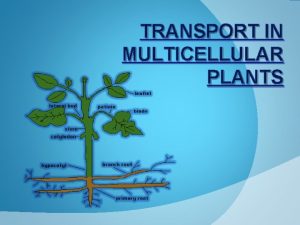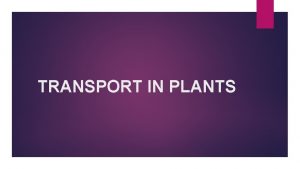Translocation in the Phloem As plants increased in


















- Slides: 18

Translocation in the Phloem

• As plants increased in size, the roots and leaves became increasingly separated from each other in space. • Thus, systems evolved for long-distance transport that allowed the shoot and the root to efficiently exchange products of absorption and assimilation.

PATHWAYS OF TRANSLOCATION The two long-distance transport pathways—the phloem and the xylem— extend throughout the plant body. Phloem is the tissue that translocates the products of photosynthesis from mature leaves to areas of growth and storage, including the roots. • The cells of the phloem that conduct sugars and other organic materials throughout the plant are called sieve elements. • In addition to sieve elements, the phloem tissue contains companion cells and parenchyma cells. • In some cases the phloem tissue also includes fibers and sclereids (for protection and strengthening of the tissue) and laticifers (latex-containing cells)

Sieve elements sieve tube elements sieve cells

• Sieve elements (sieve cells and sieve tube elements) have characteristic sieve areas in their cell walls, where pores interconnect the conducting cells


Deposition of P-Protein and Callose Seals Off Damaged Sieve Elements • The sieve tube elements of most angiosperms are rich in a • phloem protein called P-protein • P-protein is found in all dicots and in many monocots, and it is absent in gymnosperms occurs in several forms (tubular, fibrillar, granular, and crystalline • In immature cells, P-protein is most evident as discrete bodies in the cytosol known as P-protein bodies. • P-protein appears to function in sealing off damaged sieve elements by plugging up the sieve plate pores. • Alonger-term solution to sieve tube damage is the production of callose in the sieve pores. Callose, a β-1, 3 -glucan, is synthesized by an enzyme in the plasma membrane and is deposited between the plasma membrane and the cell wall.

PATTERNS OF TRANSLOCATION: SOURCE TO SINK • sap is translocated from areas of supply, called sources, to areas of metabolism or storage, called sinks. • Sources include any exporting organs, typically mature leaves and storage organ. • For example, the storage root of the biennial wild beet (Beta maritima) is a sink during the growing season of the first year, when it accumulates sugars received from the source leaves. During the second growing season the same root becomes a source; the sugars are remobilized and utilized to produce a new shoot, which ultimately becomes reproductive. • Sinks include any nonphotosynthetic organs of the plant and organs that do not produce enough photosynthetic products to support their own growth or storage needs.

Source-to-Sink Pathways Follow Anatomic and Developmental Patterns Proximity Development. Vascular connections Modification of translocation pathways.

MATERIALS TRANSLOCATED IN THE PHLOEM: • carbohydrates Sucrose is the sugar most commonly transported in sieve elements. • Nitrogen is found in the phloem largely in amino acids • and amides. • Almost all the endogenous plant hormones, including • auxin, gibberellins, cytokinins, and abscisic acid • Proteins found in the phloem include s Pproteins protein kinases thioredoxin, ubiquitin, chaperones, and proteaseinhibitors • AND SOME INORGANIC IONS potassium, magnesium, phosphate, and chloride

Velocities of Phloem Transport • Far Exceed the Rate of Diffusion • In general, velocities measured by a variety of techniques average about 1 m h– 1 and range from 0. 3 to 1. 5 m h– 1 (30– 150 cm h– 1)

THE MECHANISM OF TRANSLOCATION IN THE PHLOEM: THE PRESSURE-FLOW MODEL • movement of photosynthate is called phloem loading • Movement of photosynthate from sieve elements to sink cells is • called phloem unloading • The pressure-flow model, first proposed by Ernst Münch in 1930 • “flow of solution in the sieve elements is driven by an osmotically generated pressure gradient between source and sink. ”

• In source tissues, energy-driven phloem loading leads to an accumulation of sugars in the sieve elements, generating a low (negative) solute potential and causing a steep drop in the water potential. In response to the water potential gradient, water enters the sieve elements and causes the turgor pressure to increase. • At the receiving end of the translocation pathway, phloem unloading leads to a lower sugar concentration in the sieve elements, generating a higher (more positive) solute potential in the sieve elements of sink tissues. As the water potential of the phloem rises above that of the xylem, water tends to leave the phloem in response to the water potential gradient, causing a decrease in turgor pressure in the sieve elements of the sink. • The presence of sieve plates greatly increases the resistance along the pathway and results in the generation and maintenance of a substantial pressure gradient in the sieve elements between source and sink.


The Predictions of the Pressure-Flow Model Have Been Confirmed • The sieve plate pores must be unobstructed. • True bidirectional transport (i. e. , simultaneous transport • in both directions) in a single sieve element cannot • occur. • Great expenditures of energy are not required in order to drive translocation in the tissues along. • The pressure-flow hypothesis demands the presence • of a positive pressure gradient.

PHLOEM LOADING: FROM CHLOROPLASTS TO SIEVE ELEMENTS Several transport steps are involved in the movement of photosynthate from the mesophyll chloroplasts to the sieve elements of mature leaves, which is called phloem loading • 1. Triose phosphate formed by photosynthesis during the day is transported from the chloroplast to the cytosol, where it is converted to sucrose. During the night, carbon from stored starch exits the chloroplast probably in the form of glucose and is converted to sucrose. (Other transport sugars are later synthesized from sucrose in some species. ) • 2. Sucrose moves from the mesophyll cell to the vicinity of the sieve elements in the smallest veins of the leaf(Figure 10. 13). This short-distance transport pathway usually covers a distance of only two or three celldiameters. • 3. In a process called sieve element loading, sugars are transported into the sieve elements and companioncells.

• Photosynthate Can Move from Mesophyll Cells to the Sieve Elements via the Apoplast or the Symplast • Sucrose Uptake in the Apoplastic Pathway Requires Metabolic Energy. In the Apoplastic Pathway, Sieve Element Loading Involves a Sucrose–H+ Symporter

PHLOEM UNLOADING In many ways the events in sink tissue are simply the reverse of the events in sources. Transport into sink organs, such as developing roots, tubers, and reproductive structures, is termed import. The following steps are involved in the import of sugars into sink cells. 1. Sieve element unloading. This is the process by which mported sugars leave the sieve elements of sink tissues. 2. Short-distance transport. After sieve element unloading, the sugars are transported to cells in the sink by means of a short-distance transport pathway. This pathway has also been called post–sieve element transport. 3. Storage and metabolism. In the final step, sugars are stored or metabolized in sink cells. These three transport steps together constitute phloem unloading,
 Sugar source vs sugar sink
Sugar source vs sugar sink What are the three primary meristems
What are the three primary meristems Phloem in plants
Phloem in plants Robertsonian translocation 21
Robertsonian translocation 21 Figure 10
Figure 10 Primary cutaneous gamma/delta t-cell lymphoma
Primary cutaneous gamma/delta t-cell lymphoma Group translocation
Group translocation Translocation
Translocation Group translocation
Group translocation Reciprocal translocation
Reciprocal translocation Non reciprocal translocation
Non reciprocal translocation Chromosome disorders
Chromosome disorders Reciprocal translocation
Reciprocal translocation Translocation
Translocation Unbalanced translocation down syndrome
Unbalanced translocation down syndrome Function of sieve plate
Function of sieve plate Hnpp
Hnpp Familial down syndrome
Familial down syndrome Robertsonian translocation
Robertsonian translocation
